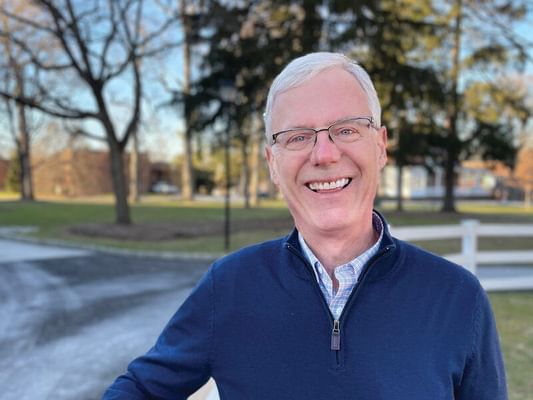- Undergraduate
Bachelor's Degrees
Bachelor of ArtsBachelor of EngineeringDual-Degree ProgramUndergraduate AdmissionsUndergraduate Experience
- Graduate
Graduate Experience
- Research
- Entrepreneurship
- Community
- About
-
Search
All Thayer News



Crowd-Solving Smarts
Welcome to the Crowd: The Power of Humanitarian Crowd-Solving
Jun 06, 2023 | by Karen Endicott | Dartmouth Engineer
Serial entrepreneur Harry Sangree '79 Th'80 introduces aid organizations to the power of crowd-solving to generate innovative solutions to tricky problems: You never know who's going to come up with a great—and doable—idea.

When COVID-19 hit in 2020, Sangree steered his latest venture, SeaFreight Labs, into new waters, recruiting nonprofit humanitarian organizations to try crowd-solving. With his wife, Lydia, Sangree is reaching out to NGOs with the global capacity to impact hundreds of thousands or even millions of lives. From his home in New Providence, NJ, he spoke with Dartmouth Engineer about the concept of humanitarian crowd-solving:
How did you first get involved in humanitarian work?
After graduating from Dartmouth, I went to Zaire for four months with Habitat for Humanity in a program I put together with funding from various Dartmouth scholarships. It wasn't part of Thayer, but the dean at the time, Carl Long, said, "If you're going to work with Habitat, come back and become an engineer when you're done." I returned for my BE year and asked my advisor, Professor Francis Kennedy, what I could do to keep helping people. He got me involved in a project to make a better brick-making machine, which we called the DartRam. We even got a US patent for it. I tested it with Habitat for Humanity in Guatemala in the mid-1980s. The design was faster and more efficient than the industry's leading model, but it broke down more. Habitat opted for maintenance over speed, so my design was shelved. But it launched my interest in humanitarian innovation.
At the time, did you have a career path in mind?
I wanted to start my own company. I had always wanted to be an entrepreneur. Then, it was not as common as it is now. People wanted to get jobs in big companies. My first job was for Exxon, and I quickly found out I'm not a good "big company" person. Big companies need people to follow the rules, the structure, and do the things that make those companies successful. Smaller companies give you lots of problems to solve and lots of reward if you can solve them smartly. I was better in the small-company, entrepreneurial environment, which is what I did for my career.
What was your entrepreneurial path?
Following my short-lived Exxon days, I went to Columbia Business School. At Columbia, I met someone who also wanted to start a company, and we heard about a guy who needed people to sell his export-management software. We said, "We could do that." We didn't know anything about exporting or software. I had learned BASIC at Dartmouth, so I had some false confidence in my technical skills. It turned out that the guy didn't want to have people selling his software after all, because he didn't want to modify it to what the market wanted. So we said, "There is a market here. Let's just do it ourselves. How hard can it be to create software?" We didn't know how hard it is, but we had this view that we could learn how to do it. I was the technical person, and my partner was the sales guy, and that was how we started our company, SYNTRA, which stands for Systems for International Trade.
Our vision was to create software to automate exporting and, later, importing. The company grew over a 17-year period from the two of us to about 200 people, with major customers, including Maytag, Trane, BASF, and Warner-Lambert. That was how I got into logistics work. Then I was on the senior leadership team of another startup, INTTRA, to bring e-commerce to the ocean container shipping industry. I started SeaFreight Labs to spur innovation in the container, shipping, and logistic space. I wanted to help companies make use of global crowd-solving to address problems such as how to decarbonize the industry.
What is global crowd-solving and how does it work?
Crowd-solving is looking outside your company for solutions to problems you have. I've partnered with the InnoCentive Open-Innovation Network/Wazoku, which links problems with more than 600,000 problem-solvers from all over the world. Companies post challenges they can’t solve internally and offer a monetary prize for solving them. People submit solutions, and the challenge sponsor evaluates the different submissions to see which is the best.
Lots of big companies and agencies—chemical and steel companies, NASA, and the military—face problems that have never been solved and nobody knows what to do about them. Putting them to the global crowd, they often get ideas their internal scientists and experts wouldn't have thought of. During the last 25 years, InnoCentive has run more than 2,500 successful challenges by leveraging people who like solving problems.
I thought this could work for container shipping, which is a very insular industry. Crowd-solving would be a way to get new perspectives. Big shipping companies have lots of money they could put up for prizes to attract lots of solvers, and if one shipping company got a problem solved, others might imitate it. I knew that anybody who has massive ships going all around the world and 100,000 employees must have problems that need solving.
"ENGS 21 showed me that you could know nothing about something and still create a solution to the problem just by trying. That's been the story of my whole career."
Harry Sangree '79 Th'80

Harry Sangree '79 Th'80 (Photo by Lydia S. Sangree)
How does humanitarian work come into play?
I was ready to launch SeaFreight Labs in March 2020 at a major trade show, and then the pandemic hit and scuttled that plan. Sitting at home, locked down, I wondered who else could use this crowd-solving process. I thought of Steve Jobs' famous quote: "The people who are crazy enough to think they can change the world are the ones who do." So I thought, why not try using the crowd to solve humanitarian problems.
I already had connections with Habitat for Humanity and World Vision, which helps people globally. I reached out to both organizations and told them about crowd-solving. Each initiated a project with me to see if we could find some hard problems that were crowd-solvable, then put them out to the crowd and see what would happen. During the next two years we ended up running eight challenges. Six got good solutions, and four are being field-tested—two in Kenya and one each in the Philippines and Mexico.
One of the problems World Vision posed was related to clean water in Africa. Moving beyond digging wells, World Vision is now building low-pressure water systems to pipe well water to each house. But then you have to use chlorine to clean the water sitting in the pipes, and commercial chlorine sensors cost $5,000 to $6,000. World Vision wondered if somebody could invent a sensor that costs one-tenth that price. InnoCentive/Wazoku said, if World Vision wants to run the challenge, we're willing to do it. SeaFreight Labs helped convince professors, scientists, and others to take it on. We got 22 quality submissions. One is close to costing one-tenth the price of current sensors, and World Vision is building some units to send to Kenya for testing in rural communities. That's very exciting.
Another test case centers on helping rural Kenyans keep mosquitoes out of their mud-and-thatch houses to lower their risk of contracting malaria—for under $200. Someone who answered the challenge had the idea of cutting holes into the mud walls, inserting PVC pipe, and putting mesh over the pipe openings—achieving light, ventilation, and protection from mosquitoes. A retrofitted home tested in a controlled environment had 89 percent fewer mosquitoes. The next test will compare mosquito rates in 30 retrofitted houses and 30 traditional houses. The World Health Organization asked us to let them know what happens, because if the idea works, they want to help spread it more widely.
These projects show the power of asking everybody, "Can you think about this?" and then incenting them with prize money and seeing what happens. Humanitarian crowd-solving doesn't always have stories like that, but it's had enough.
What role does SeaFreight Labs play?
As the founder of SeaFreight Labs, I've joined the "Pledge 1%" movement started by the CEO of Salesforce, Marc Benioff, who thought companies have a responsibility to do more than just make money for their shareholders. Companies should donate one percent of their product, time, or resources to a charity of their choosing. I signed up SeaFreight Labs early in the pandemic to help promote and run humanitarian crowd-solving projects.
Did you coin the term "humanitarian crowd-solving"?
I did. I applied to a Fast Company magazine competition for the "Best World-Changing Ideas." I described the work I was doing for Habitat and World Vision as humanitarian crowd-solving. We got an honorable mention in the North America category in 2021.
What are you working on at the moment?
We're in the early stage of working with another international agency on open innovation through humanitarian crowd-solving. The engineers at Dartmouth would all understand open innovation as the category name for this kind of work.
It sounds as though it's straight out of ENGS 21, Thayer's introductory engineering course. What was your ENGS 21 project?
It's what made me decide that engineering was right for me. The project was called Deadweight Enterprises. At the time, Dartmouth was one of the national leaders in the 35-pound weight event, the indoor version of the hammer throw. The 35-pound weight is a large plastic ball with lead weights in it. The guy spins around three times and then throws it. The problem was that when it landed, the ball sometimes popped open and lead pellets would go across the floor. We tried to solve that problem. We created a lead ball with a polyethylene material around it that could absorb energy when it fell on the ground. It never became commercial, but we were proud of our solution. And, for people who hadn't taken any engineering classes, it was amazing that we got this whole thing built. We were calling up manufacturers about various materials and getting them to give us samples and actually got somebody to build us a prototype. The track coach tried it and said, "It's 35 pounds and it doesn’t break. It's good."
ENGS 21 showed me that you could know nothing about something and still create a solution to the problem just by trying. That’s been the story of my whole career.
Did your Thayer education influence your thinking about how to solve complex problems?
There were four things Thayer taught that really influenced my life. The first is Thayer's generalized view of engineering, which is helpful for problem solving because you aren't stuck in a single silo looking at things a certain way. You can think more broadly. Second, you need to have a team with interdisciplinary skills, as in ENGS 21. No one of us could have achieved the results we got by ourselves. You need people with different perspectives, capabilities, and interests. Third, solutions are not just technical—there are people issues and process issues—and a solution needs to have all three of those threads together being worked on. And last, to solve complex problems, you need to think about all these things at the same time and iterate over and over again. These are lessons I've applied to all my endeavors.

Crowd-Solving Smarts
Harry Sangree's advice on posing a good problem:
Defining a good problem is key to successful crowd-solving. The problem can't be unrealistic—such as eradicate malaria or solve inflation in developing companies—and should be narrow in scope so the global crowd can contribute ideas you haven't thought of, including repurposing existing solutions from other domains and applying them to the aid sector. In my experience, problems are best identified by the people doing the work on the ground.
I subscribe to InnoCentive cofounder Alph Bingham's "LASSO" criteria for defining a good problem:
- Limited in Scope: A solution can be generated by one person or a small team in less than a few weeks.
- Actionable: A solution can be implemented by the organization on a timely basis.
- Specific: The problem statement must be clear with key constraints such as cost and materials explicitly stated.
- Supported: The problem must be important to your organization's objectives.
- Owned: An expert should "own" the problem statement and a senior official of the organization should "own" any plan for implementation.
In addition, I think humanitarian organizations should focus on problems that also meet these two criteria:
- High-Impact: Any solution should have the potential to impact at least tens or hundreds of thousands of people (this type of problem is most likely to attract many diverse solvers and generate scores of quality proposals).
- Universal: Any solution should be something that can be shared across the humanitarian space and applied by other NGOs.
Karen Endicott is a former director of communications for Thayer and a former editor of Dartmouth Engineer.
For contacts and other media information visit our Media Resources page.
